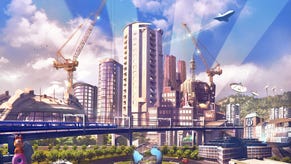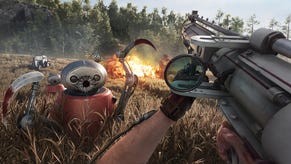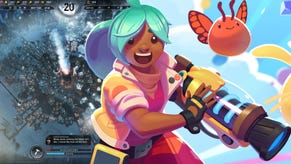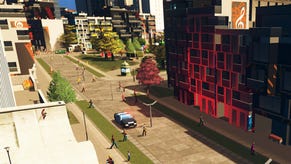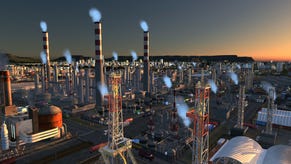A Cities: Skylines Succession Diary, Part 1: Crimewave
Three mayors, one city, all the disasters
Cities: Skylines is great and all, but I must confess to being hamstrung by my imagination, or lack thereof. Once I've unlocked everything there is to build, I kind of run out of steam, because I don't have a designer's mind and complicated road systems scare me. But a friend, also playing the game and experiencing similar handicaps, had an idea: a succession game in which three of us take turns to co-operate on one city, passing on the savefile to the next person every time the city levelled up, and hoping something beautiful rather than catastrophic would emerge.
Given we've managed to suffer two major disasters (and bear in mind that this is not a game which usually invites much disaster) within the game's earliest stages, so far I'm leaning towards catastrophic.
Joining me for this succession diary are Jonathan Shipley and Dan Corns. Neither play many games, but both spent time with assorted Sim Cities in the past - interestingly, they found their way to Skylines without my prompting, which perhaps says much about the reputation it's gotten as heir apparent to Maxis' ailing citybuilder progenitor.
DAY 1: Damned If You Donut
Jonathan:
Our city-to-be is called ‘The Room’, in a play-with-your-perceptions flight of fancy. I started populating The Room, although the first level up, Little Hamlet kicks in awfully fast. Anyway. The good news is that we are not yet bankrupt, and at the end of my tenure we are making a little bit of money, but obviously I have not had the chance to do much.
The bad news is that I have inflicted my love of low-rise housing on the other two, so the first 501 residents are living in a sort of shanty town, which by tremendous good fortune is right next to the vile industrial complex in which they ply their meagre trade. I like to think of it as analogous to Bodie’s low-rises in Baltimore. The other good news is that plenty of doughnut shops have opened immediately. I would be worried about the constant sugar-rush depriving the sims of sleep, but the enormous, pretty wind turbine I built in the heart of the residential district should have already set the tone of sleep deprivation.
This is where I got to before Little Hamlet kicked in:
As you can see, I have planned for an industrial zone in the heart of town with commerce surrounding it. If anyone wants to figure out how the industry get their goods back to the highway efficiently for me, that would be grand.
Priorities: obviously now that we’re a hamlet we can probably expect a massive rubbish problem imminently, so the next one up will have to build some landfill. Also, I’ve tried to build a simple one-way system so I propose we don’t build alongside the roads in off the highway, as the goal is for traffic to keep moving rather than stopping to buy hats and scarves. Lastly, I’ve left quite a lot of gaps between houses; the intention was to build paths there later, but you guys can of course overrule me there.
DAY 2: Road Warriors
Dan: Naturally I immediately decided to break out of Jonathan‘s road scheme. Too many roads to building space ratio, I think. Therefore I laid the foundations to a more orderly new settlement on the outskirts of the existing city. Gaps have been left for future train tracks or tree breaks.
I also built a water pump, a medical centre, which was popular, a couple more wind turbines and a rubbish dump - which wasn’t very popular. It's begun to feel like a city rather than just a big car park.
Jonathan: So, our first intra-mayor dispute concerns this bit of land:
All four roads coming in from the highway (the two straight roads and the two diagonals) are one way roads, and it was my intention to keep them free of businesses and homes, for two simple reasons:
1. Entry to the cities in Skylines seems to be a huge bottleneck further down the line. Getting people off the highway quickly and without traffic lights or reasons to pull over is important.
2. Those poor guys over on the right hand side live on a one way road out of town. Not only will traffic past them be pretty relentless, they’ll only be able to use their own cars to leave the city. Yes, they can do a loop and come back in on the other lane, but it’s not exactly perfect town planning. And while they might have the wherewithal to leave town and come back in, I know for a fact that the garbage trucks and hearses don’t think that way. So those nice little homes will soon be piling up with litter and disintegrating bodies.
But my successor as Mayor, Dan - as the photo shows - clearly didn't realise that, or more likely decided to screw me over, loathing in his venal way my unique egalitarian mayoral qualities. And I am banking on Alec to free our citizens from their one-way squalor when he assumes office.
On page two: overzealous bowels and a city-wide crime spree.
DAY 3: Criminal Inaction
Alec: The city Jonathan and Dan built is full of shit, if I’m honest.
That’s why the first thing I did was add a new sewage treatment pipe. The citizens of this thrice-accursed wannabe metropolis were generating a frankly disproportionate amount of bodily waste, far more than our existing sewage outlet could cope with, and while I was puzzled that a second pipe was required so soon, I couldn’t for the life of me identify any piping or power error which might have lead to this. The choice was a second poo-pipe or half the city perishing of unspeakable infection. While bequeathing a foul-smelling ghost town to my successor held some appeal, for now I chose the more humanitarian approach.
Dan had also left a small tract of city, just off the highway junction, without water, so between that and spraying the fish with further excrement, the lion’s share of the withered public purse I inherited was spent on pipes.
I was aware that the convoluted one-way system and concentration of homes right next to a freeway which carried enough cars to ruin at least nineteen planets’ atmospheres was going to come back to bite us later, but quite frankly it wasn’t my bed and I wasn’t going to lie in it. Instead I turned my attention to simple expansion, zoning out first a new industrial area some distance out of town, as my inconsiderate forebears had decided to construct stinky great factories right next to the first houses.
Then, with my mind still on making at least some parts of this city non-horrific to live within, I built a reasonably sizeable new residential area to the North (with a scattering of shops) then making a right old pig’s ear of providing power to it. Thanks to an unspoken personal rule of minimal bulldozing, I left this budding conurbation bifurcated by messily-placed pylons, and several blocks’ worth of rear windows staring right onto a wind farm. Still, at least their toilets work.
This new suburb (or is it mere urb? Too soon to say) was a long drive and far too many one-way roads from the city’s sole garbage dump, so I built a simple service road which I hoped would provide a more direct route for dump trucks without commuters being tempted to use it as a shortcut. Time, and irate motorists, will tell.
Too late, I realised that the damnable one-way system meant the dump trucks would need to tour the entire south side of the city just to get to this new service road. I attempted a fix, by making the stretch of road just outside the dump two-way, but didn’t have a chance to see how this would play out before the new suburb filled up, the settlement expanded to Tiny Town and I had to pass the baton back to Jonathan.
Though I did have time to notice that, suddenly, crime was everywhere.
Presumably because I’d just messed up the road system so much that the rozzers couldn’t get to half the town. I might have fixed the poo-poo, but I’d broken the po-po. I’d love to say this was deliberate malice, but it only seems fair to reveal my innate impotence at this early stage. In any case, I’m relieved to not have to clean up this particular mess myself.
DAY 4: Skylines Expansion
Jonathan: My second term of office in Skylines was easily the most satisfying and exciting couple of hours I’ve yet spent in the game, for reasons I will go into in my next post, but in the meantime, I will do a quick change log of the things I sought to do in this, the fourth edit of our strange, collective city.
I started by trying to arrest a few of the problems I had inherited; the most notable being a crime wave of epic proportions. Clearly during Alec’s tenure – a period of expansion – some mistakes had been made in relation to law and order. Essentially, from what I could see, the Crips and the Pirus had broken out in open warfare in the industrial district. I built a new police station and sent the boys out to crack a few heads. Problem solved.
As Alec pointed out in his last post, our population, while very nice, are compulsive crappers. Until he sorted the problem, they were essentially producing more than their body weight of effluence every single day. With the extra sewage provision he added this needn’t be a problem, but I felt a bit worried about the fact that our sewage pipes were pumping their contents out directly onto the coast and the polluted water was swilling around our most attractive piece of coastline. The situation wasn’t helped by the fact that having chosen a tropical map, we didn’t have much of a tide and I had visions of hauling shit-soaked seabirds out of the water in a few months.
So I made a tactical decision to invest in our first land expansion. We have now acquired a large piece of land to the city’s East, which secures us access to a fast flowing river and a lagoon over to the South East which, while picturesque, didn’t have the tourist potential of our Gold Coast. I built a big pipe, relocated our drain pipes and a wind turbine down there and began pumping our waste into it. Hopefully we can treat that water later. More importantly, the waste on our shoreline began to dissipate.
Having addressed one infrastructure problem, I began to look anxiously at another. (Spoiler: this was not a great term in office for me – I may not be re-elected). I felt our city had been undermined from the start by my inefficient road planning, which had created a host of problematic intersections by the low-rise housing, and which had been exacerbated by Dan’s haphazard zoning along my one way roads.
Stung by my fellow mayors’ criticism of my layout, I remapped the roads and began re-examining the route in from the highway. It was evident that our industry had no direct route in and out of town. I shifted some stuff around; relocated a wind turbine and a water tower (of which more later) and built a big four line road up to the new industrial district which Alec had created. I felt this would stop the bottleneck and encourage the city to grow.
At this point I decided some districts were needed. So our first settlement, the small low-rise residential area we started with, which is just below the middle of our overall map, became ‘Lower S. Central’. Dan’s new residential suburb to the East became, predictably, ‘The East Side’ and Alec’s new industrial zone towards the coast became the ‘Lower East Side’.
(This screenshot shows the city from the North, so it’s upside down, hence the East Side appearing on the West, etc).
Industry bugged me. One definite advantage of Cities Skylines over Sim City is that industrial pollution doesn’t seem to travel quite so far, meaning it’s possible to build factories and homes in the same district, but the unsightly purple pollution never allows you to forget what you’re doing to your population. Also, we had two industrial zones which didn’t quite connect.
I decided to create a buffer district between the residential and industrial areas which could still do some heavy lifting, economy-wise. Consequently I changed policy in my first industrial zone and expanded the district South, reaching down around the edges of the Lower East Side. In this buffer industry zone I decided we should specialize in forestry. So this area – called ‘The Woods’ – is like a protective chalice inside which the heavy industry proper sits. It shields our population from the negative effects of industrial pollution.
It also created a problem in itself, which is that because we don’t have much natural forestry, the roads swiftly became heavy with huge lorries carrying imported wood. My successor may need to either create a better one way road in and out of The Woods or look for some natural forestry elsewhere on the map so we can import wood from there, rather than the highway. Either way, traffic remains very heavy in Lower S. Central.
Nonetheless, I was feeling pretty proud of myself at this point. I noted my population was creeping up towards 2,600 people. We were on the verge of becoming a Boom Town. Forestry had dramatically cut pollution. The Coast was recovering and the East Side was growing fast.
Then everyone died.
Coming soon in part two: the brown apocalypse.













